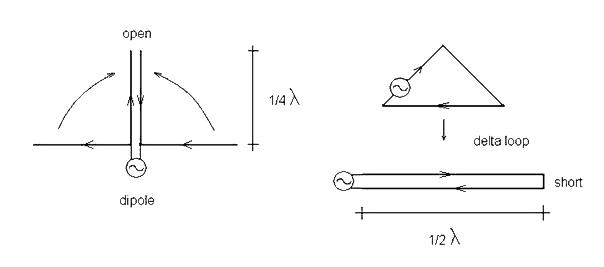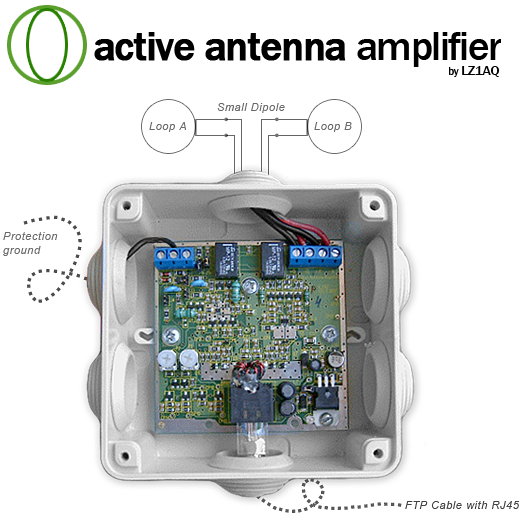HF Antennas: Vertical or Horizontal?
Serge Stroobandt, ON4AA
Copyright 2013–2020, licensed under Creative Commons BY-NC-SA
- Home
- Antenna Designs
- Vertical or Horizontal?
Summary
If you can have only one antenna and can chose between a vertical HF antenna or a relatively high horizontal HF antenna, go for the horizontal antenna! Wide‑band active small magnetic receiving loops (not to be confused with tuned magnetic loops) offer, when mounted close to the ground, improved noise immunity at reception.
Modelling results
In January 2008, —as little as three months before his lamented dead— L. B. Cebik, W4RNL (SK) published what was going to be the last entry of his seminal 10–10 News series.1 It turned out to be an interesting gain comparison of single element 28.4 MHz antennas modelled over various ground types of which a summary is presented here (Table 1). His findings seem to fit well with what John Devoldere, ON4UN modelled and published for equivalent antennas on the lower HF bands.2 This led me to write up the following synopsis.
| polarisation | antenna | hagl | salt water | very good | average | very poor |
|---|---|---|---|---|---|---|
| vertical | \(\frac{\lambda}{4}\) monopole with 32 buried radials | 0 | 4.27 dBi 11° | -0.56 dBi 24° | -0.31 dBi 27° | -1.69 dBi 29° |
| vertical | \(\frac{\lambda}{2}\) dipole | 1 ft | 5.64 dBi 8° | 0.69 dBi 17° | 0.55 dBi 18° | 0.15 dBi 21° |
| vertical | \(\frac{\lambda}{4}\) monopole with 4 elevated radials | \(\frac{\lambda}{4}\) | 6.31 dBi 7° | 0.82 dBi 14° | 1.15 dBi 16° | 1.24 dBi 19° |
| horizontal | \(\frac{\lambda}{2}\) dipole | \(\frac{\lambda}{2}\) | 8.36 dBi 29° | 7.73 dBi 28° | 7.24 dBi 28° | 6.48 dBi 27° |
Horizontal HF antennas
… benefit from nearby ground gain
At a height of about λ/2, the nearby ground reflection of a horizontal HF antenna will start to be constructive at interesting take-off angles for long- distance ionospheric contacts. This will provide a net gain over the antenna in free-space.
Vertical HF antennas
… suffer from nearby ground loss
This is not the case with vertical HF antennas. Nearby ground only contributes loss. This even more so when the ground forms part of the return path of the radiating structure. Even when far-away ground reflections may cause the directivity of a vertical HF antenna at low take-off angles to be much higher than that of a horizontal HF antenna, its net gain will still be lower at those angles. This makes the horizontal HF antenna a clear winner, at least for what transmission is concerned. Note that gain and directivity are not synonyms; gain takes into account losses, directivity does not.
Vertical HF antennas still remain useful
Vertical HF antennas do have their merit though. At the lower end of the HF spectrum, the λ/2 height requirement for horizontal antennas can become cumbersome (even though horizontal phased arrays have a less stringent minimum height requirement). A vertical HF antenna can get away with a height of only λ/4. Furthermore, if the return conduction current of a vertical radiator flows through salt water, losses will be lower. Finally, the directivity of a vertical HF antenna can be effectively employed at the reception end to cancel out high-angle interference caused by near-by stations. This is why some stations use receive-only phased arrays of verticals on the low bands.
Polarisation & noise
Polarisation is not really an issue at HF. This is because the ionosphere is mainly an anisotropic medium, i.e. it messes up polarisation. However, horizontally polarised antennas are again preferred over noisier verticals because of the following considerations pertaining the polarisation of noise signals:
- Earth-to-cloud lightning (QRN) is vertically polarised.
- Vertically polarised man-made noise (QRM) propagates longer distances over ground than horizontally polarised man-made noise. Consequentially, the capture area for vertically polarised man-made noise is much larger than that of horizontally polarised man-made noise —actually, by a factor of the difference in ground wave propagation distance squared!
Common mode input impedance & noise
Antenna input impedances differ between differential and common mode, as well as between different antenna types.3 The differential and common mode input impedance of an antenna can be derived by considering the antenna as a two‑wire, respectively single‑wire, transmission line (Figure 1). My article about common mode chokes explains this in further detail. Antennas with a high common mode input impedance (see Table 2) will receive less noise from interfering sources in the near field.

Figure 1: Deriving the conducted common mode input impedance of a center‑fed half‑wave dipole and an edge‑fed full‑wave delta loop. Source: ©2007 Jan Simons, PA0SIM
| input impedance | differential mode | common mode |
|---|---|---|
| center-fed half-wave dipole | low | low |
| full-wave loop | low | high |
| folded half-wave dipole | medium | high |
Small magnetic loops
The above mentioned points about the polarisation of noise also hold true for wide‑band active small magnetic receiving loops (not to be confused with tuned magnetic loops) when mounted close to the ground.
However, there is an additional reason why active small magnetic receiving loops are so successful at improving noise immunity:
- Namely, the magnitude of the electrical field strength \(|\mathbf{E}|\) in the near field of human made noise sources is often much higher than 376.37 times the magnitude of the magnetic field strength \(|\mathbf{H}|\).
Small magnetic loops with a circumference \(C < \frac{\lambda}{10}\) are not sensitive to the more pronounced electrical field strength emitted by nearby noise sources.
Only plane waves in the far field exhibit the characteristic impedance of free space, which is exactly:
\[Z_0 = \frac{\left|\vec{E}\right|}{\left|\vec{H}\right|} = \sqrt{\frac{\mu_0}{\epsilon_0}} = \mu_0\cdot c_0 \approx 376.73\,\Omega\]
\(c_0 = 299\,792\,458\,\frac{\text{m}}{\text{s}}\): the speed of light in free space
\(\mu_0 = 4\pi\cdot10^{-7}\frac{\text{H}}{\text{m}}\): the free space permeability
\(\epsilon_0 = \frac{1}{\mu_0 c_0^2}\): the absolute permittivity of free space
\(Z_0\): the characteristic impedance of free space
References

This work is licensed under a Creative Commons Attribution‑NonCommercial‑ShareAlike 4.0 International License.
Other licensing available on request.

Unless otherwise stated, all originally authored software on this site is licensed under the terms of GNU GPL version 3.
This static web site has no backend database.
Hence, no personal data is collected and GDPR compliance is met.
Moreover, this domain does not set any first party cookies.
All Google ads shown on this web site are, irrespective of your location,
restricted in data processing to meet compliance with the CCPA and GDPR.
However, Google AdSense may set third party cookies for traffic analysis and
use JavaScript to obtain a unique set of browser data.
Your browser can be configured to block third party cookies.
Furthermore, installing an ad blocker like EFF's Privacy Badger
will block the JavaScript of ads.
Google's ad policies can be found here.
transcoded by
 .
.



